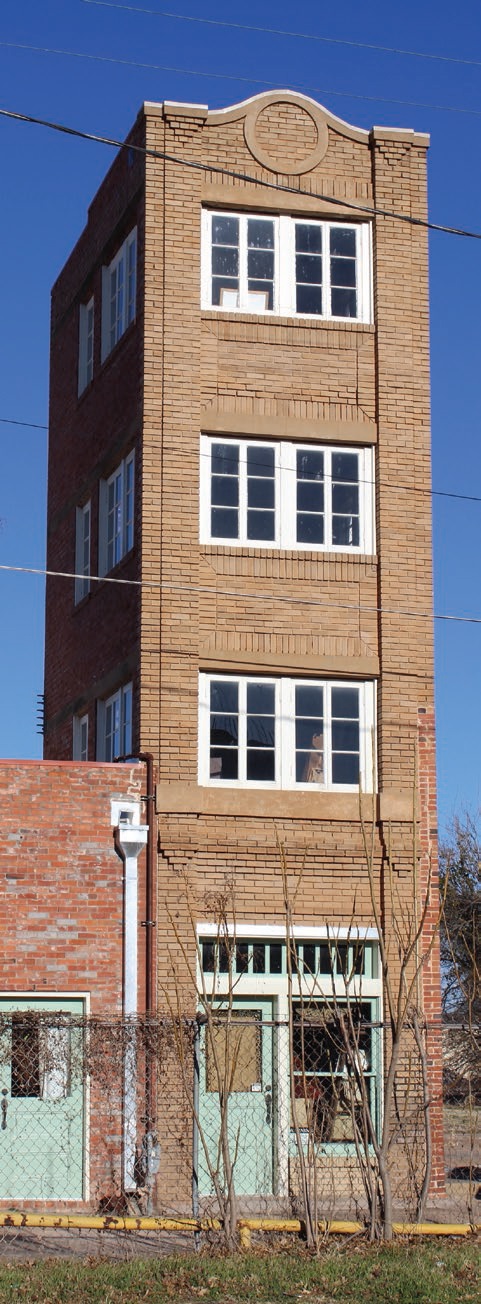Conned but not forgotten
Evan Zabawski | TLT From the Editor June 2018
Once rich with oil, Wichita County is now rich in history.

Known as the ‘world’s littlest skyscraper,’ the Newby-McMahon building sits as a reminder of a bygone era of fast money and fast talkers.
Photo courtesy of Travis K. Witt, CC BY-SA 4.0, https://commons.wikimedia.org/w/index.php?curid=46753328.
At the turn of the last century, rancher Samuel Burk Burnett established the Four Sixes (6666) Ranch, some of which rested on land leased from the Comanche. When the federal government ordered the land turned back to the tribes, Burnett traveled to Washington to meet President Theodore Roosevelt who then granted all ranchers a two-year extension on their leases.
In the spring of 1905, during a visit to the lands and ranchers he had helped, Roosevelt was entertained by Burnett at his home near Nesterville, Texas, where they participated in a bare-handed wolf and coyote hunt. Their friendship grew over the years, so much so that during a visit in 1910 Roosevelt suggested the town be renamed Burkburnett in his honor.
On July 29, 1918, just outside of town on S.L. Fowler’s farm, a wildcat well struck oil at 1,734 feet. Just three weeks later there were 56 drilling rigs in operation, and by June 1919 there were more than 850 producing wells, earning Burkburnett the nickname of Boomtown, USA.
This time period was immortalized in song and story; the most well-known version appeared in the August 1939 issue of Cosmopolitan magazine entitled A Lady Comes to Burkburnett, written by James Edward Grant. This short story served as the inspiration for the 1940 film Boom Town, starring Clark Gable and Spencer Tracy as fellow wildcatters.
One of the other permanent markers of the time sits just a little way south in downtown Wichita Falls. In the wake of booming business, oilmen were desperate for office space, and they thought they found their answer with a con man out of Philadelphia: J.D. McMahon.
McMahon’s oil-rig construction firm was a tenant of the Newby Building, a single-story brick building near the railway depot. McMahon proposed that he construct a high-rise annex to add some much-needed office space. He managed to wrangle $200,000 from investors (almost $3 million today) using blueprints drafted with a very clever mistake.
What investors saw listed for height was mistaken as 480’(feet), when the reality was actually 480” (inches). By using his own crew, the building was nearly complete before the investors realized they had been taken. They took him to court, but since the blueprints matched the finished product the court ruled in McMahon’s favor.
To make things worse, the crew originally contracted for the elevator backed out, so the only way to access the upper floors was an external ladder. Years later, an internal stairwell was added, occupying approximately a quarter of the already cramped 11’ by 19’ footprint of the building.
Left without recourse, oil companies moved into the office space until the boom died down a few years later. By the time the Depression hit, the building had been vacated and boarded up. After a fire gutted the building in 1931 it became unusable and sat for decades.
Once the economy recovered, the building was occupied briefly by a barbershop and cafés but continued to change hands. Though it was slated for demolition, it avoided this fate and was deeded to the city. After years of further deterioration, the city gave the building to the local historical society in hope that it might carry out a restoration. By 1999 the society could no longer afford to keep the building.
In 2000 a local architectural firm was hired by city council to stabilize the structure. The firm partnered with another local business and purchased the building. Delayed by storm damage in 2003, the building was finally restored in 2005 and re-opened.
Known as the “world’s littlest skyscraper,” the Newby-McMahon building sits as a reminder of a bygone era of fast money and fast talkers.
Evan Zabawski, CLS, is the senior technical advisor for TestOil in Calgary, Alberta, Canada. You can reach him at ezabawski@testoil.com.